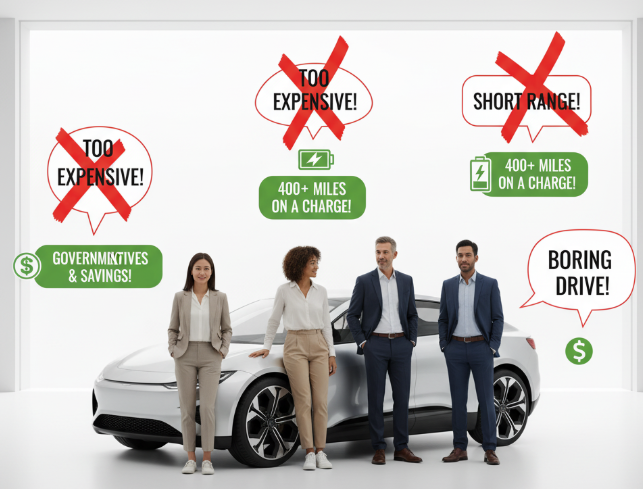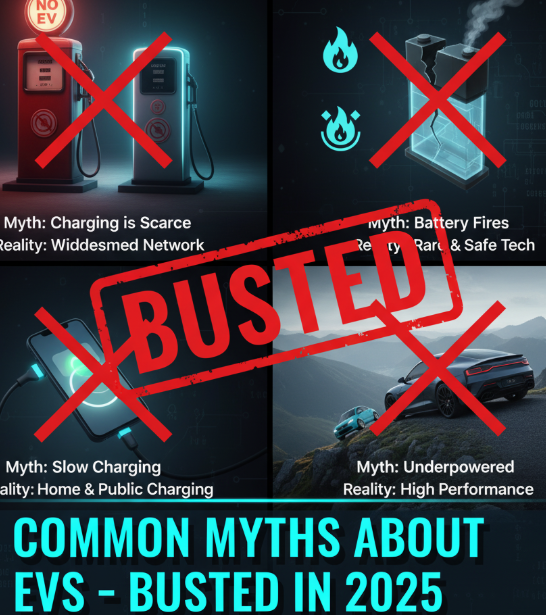Introduction: Why EV Myths Still Exist
Electric vehicles (EVs) are no longer rare. By 2025, millions of drivers in the USA, Canada, Europe, and Asia use EVs daily. Charging stations are everywhere, battery ranges are climbing, and new EV models are hitting the roads every year.
Still, myths about EVs continue to spread. Some people believe EVs can’t handle long trips, others think batteries won’t last, and some say EVs are too expensive. Most of these ideas started years ago, when EV technology was new. But today, with improved batteries, faster charging, and government support, these claims are outdated.
In this article, we’ll break down the most common EV myths in 2025 and show you the real facts.
Myth 1: EVs Don’t Have Enough Range
One of the oldest fears about EVs is “range anxiety”—the idea that your car will run out of power before you reach your destination.
The Reality in 2025
- Most new EVs in 2025 offer 250–400 miles per charge.
- Premium EVs (like Tesla Model S Plaid or Lucid Air) can go 500+ miles on a single charge.
- Even budget EVs such as the Chevy Bolt EUV or Nissan Ariya easily handle 220–280 miles.
| Year | Average EV Range | Notes |
|---|---|---|
| 2015 | 80–120 miles | Only early EVs like Nissan Leaf |
| 2020 | 180–250 miles | Big improvements in lithium-ion batteries |
| 2025 | 300+ miles | Solid-state and long-range lithium batteries |
✅ Fact: For most drivers, daily travel is less than 40 miles. EVs already provide far more range than needed.
Myth 2: Charging Takes Too Long
People often imagine sitting for hours while their EV charges.
The Reality in 2025
Charging speed depends on the charger type:
- Level 1 (Home 120V): 3–5 miles per hour – slow, but good for overnight trickle charging.
- Level 2 (240V Home/Workplace): 20–40 miles per hour – perfect for daily charging.
- DC Fast Charging: Adds 200–300 miles in 20–30 minutes.
- Ultra-Fast Chargers (350 kW): Can charge 10–80% in 15 minutes (popular on highways).
🚗 Real-World Example: A Tesla Model Y can go from 10% to 80% in about 20 minutes at a Supercharger.
✅ Fact: Charging time has dropped dramatically. For road trips, a short meal or coffee break often gives enough charge.
Myth 3: EVs Are Too Expensive
Many people assume EVs are “luxury only” and cost far more than gas cars.
The Reality in 2025
Prices are falling every year. In fact:
- Average EV price (2020): $55,000
- Average EV price (2025): $39,000
- Average gas car price (2025): $34,000
With tax credits, rebates, and lower running costs, EVs are often cheaper overall.
Cost of Ownership (5-Year Comparison)
| Category | Gas Car | EV |
|---|---|---|
| Fuel/Electricity | $8,500 | $3,000 |
| Maintenance | $4,000 | $1,500 |
| Tax Credits (avg) | $0 | –$7,500 |
| Resale Value | Medium | High |
| Total | $12,500 | –$3,000 |
✅ Fact: EVs cost more upfront but save thousands of dollars over time.
Myth 4: EV Batteries Don’t Last
A common myth says EV batteries die after a few years, just like phone batteries.
The Reality in 2025
- Modern EV batteries last 300,000–500,000 miles.
- Most EVs come with 8–10 year warranties.
- Battery recycling programs reuse old cells.
Battery Lifespan Example
- Tesla Model 3 batteries retain 90%+ capacity after 200,000 miles.
- Hyundai Ioniq 5 offers a 10-year/100,000-mile warranty.
✅ Fact: EV batteries are designed to outlast most gas engines.
Myth 5: There Aren’t Enough Charging Stations
Some drivers believe charging stations are rare and hard to find.
The Reality in 2025
- USA: Over 160,000 public charging stations.
- Canada: More than 20,000 charging ports.
- Apps like PlugShare, ChargePoint, and Tesla Supercharger maps make it easy to locate chargers.
Map Growth of Charging Stations in North America
| Year | Charging Stations in USA | Charging Stations in Canada |
|---|---|---|
| 2015 | 10,000 | 2,000 |
| 2020 | 50,000 | 8,000 |
| 2025 | 160,000+ | 20,000+ |
✅ Fact: Most EV drivers charge at home overnight, making public chargers more of a road-trip convenience.

Myth 6: EVs Are Bad for the Environment
Critics claim EVs aren’t “truly green” because of battery mining and electricity production.
The Reality in 2025
- EVs produce 50–70% fewer lifetime emissions compared to gas cars.
- Grid electricity in the USA & Canada now includes 40–50% renewable sources.
- Battery recycling reduces mining impact.
Emissions Over 10 Years
| Vehicle Type | Lifetime CO₂ Emissions |
|---|---|
| Gasoline Car | 60–70 tons |
| Hybrid | 40–50 tons |
| EV | 20–30 tons |
✅ Fact: Even when charged with some fossil fuels, EVs are cleaner overall.
Myth 7: EVs Can’t Handle Cold or Hot Weather
Skeptics argue EVs fail in extreme climates.
The Reality in 2025
- Cold weather can reduce range by 10–20%, but new heat pump systems minimize losses.
- Pre-conditioning (warming or cooling while plugged in) ensures comfort.
- Norway, one of the coldest countries, has the highest EV adoption rate in the world.
✅ Fact: Gas cars also lose efficiency in extreme weather. EVs now include climate tech to perform well year-round.
Myth 8: EVs Are Unsafe in Accidents
Some believe EVs are fire hazards or unsafe in crashes.
The Reality in 2025
- EVs must pass the same safety standards as gas cars.
- Battery fires are rare (less common than gas car fires).
- EVs often score 5-star safety ratings due to low center of gravity.
🚦 Example: Tesla Model Y and Rivian R1S both have top safety ratings in 2025.
✅ Fact: EVs are among the safest vehicles on the road.
Myth 9: EVs Can’t Tow or Haul Heavy Loads
Truck owners often argue EVs can’t replace gas trucks for towing.
The Reality in 2025
- Ford F-150 Lightning: 10,000 lbs towing capacity.
- Rivian R1T: 11,000 lbs.
- Tesla Cybertruck (2025): 14,000 lbs.
✅ Fact: EV trucks match or exceed gas trucks in towing—though range decreases with heavy loads.
Myth 10: EVs Don’t Have Enough Models or Choices
Years ago, only a few EVs were available.
The Reality in 2025
- Over 150 EV models available globally.
- Categories include:
- Compact cars (Chevy Bolt EUV, Nissan Leaf Plus)
- Sedans (Tesla Model 3, Hyundai Ioniq 6)
- SUVs (Kia EV9, Ford Mustang Mach-E)
- Pickup trucks (Cybertruck, Ford Lightning, Rivian R1T)
- Luxury EVs (Lucid Air, Mercedes EQS)
✅ Fact: By 2025, there’s an EV for every budget and lifestyle.
Myth 11: EVs Can’t Handle Road Trips
Some think long drives are impossible with EVs.
The Reality in 2025
- Cross-country EV trips are common thanks to nationwide charging networks.
- Apps plan routes with charging stops.
- Charging breaks often align with meal or rest stops.
✅ Fact: With planning, EV road trips are easy and enjoyable.
Myth 12: EVs Will Overload the Power Grid
Critics argue millions of EVs will crash the electric grid.
The Reality in 2025
- Studies show EV adoption increases demand by only 2–3% per year.
- Smart charging allows cars to charge overnight when demand is low.
- Vehicle-to-grid (V2G) technology lets EVs give power back during peak hours.
✅ Fact: EVs actually help stabilize future grids.
Myth 13: EVs Don’t Sound Powerful
Some drivers miss the roar of a gas engine.
The Reality in 2025
- EVs are quieter, smoother, and faster.
- Instant torque means EVs often beat gas sports cars in acceleration.
- Some EVs even offer artificial engine sounds for fans of “vroom.”
🚗 Example: Tesla Model S Plaid goes 0–60 mph in under 2 seconds.
✅ Fact: EVs deliver unmatched performance.
Myth 14: EVs Are Only Good for Cities
People think EVs are just “urban commuter cars.”
The Reality in 2025
- Long-range EVs handle highways with ease.
- EV pickups dominate rural and off-road use.
- Charging stations are spreading in smaller towns too.
✅ Fact: EVs fit city, suburban, and rural lifestyles.
Myth 15: EVs Are Just a Passing Trend
Skeptics say EVs are a “fad” that won’t last.
The Reality in 2025
- Over 20% of new cars sold in the USA are EVs.
- Canada aims for 100% zero-emission sales by 2035.
- Major automakers like GM, Ford, and Volkswagen are going all-electric.
✅ Fact: EVs are the future of driving, not a temporary experiment.
Conclusion: The Road Ahead in 2025
The EV revolution is real. From longer ranges and faster charging to affordable models and nationwide charging networks, myths about EVs no longer hold up.
- EVs are cleaner, cheaper, and safer.
- They can handle road trips, towing, and extreme weather.
- More models mean more choices for drivers in every price range.
By 2025, EVs aren’t just an option—they’re becoming the standard. The next time someone repeats an EV myth, you’ll know the facts.
👉 Final Thought: Switching to an EV in 2025 isn’t about the future. It’s about making the smart choice today.

Leave a Reply